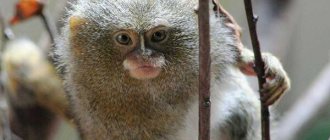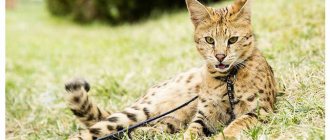Pygmy marmosets
- This is the smallest representative of the primate family. And if keeping other monkeys in the house requires a lot of space, then a tiny marmoset does not require much space, since they reach only 15 cm and weigh about 150 grams. The monkey's body is covered with golden fur, and the fur on its head creates an imitation of a mane, which looks very cute and funny. Thanks to its fur, the animal looks larger than it actually is. Their lifespan in captivity is approximately 15 years. When purchasing a pet, you need to find out from the seller whether the animal was born in captivity or was caught in the wild. After all, a lot depends on this: it is difficult to retrain a marmoset born in natural conditions to live in a cage, and this can also affect the pet’s life expectancy. The price of one individual starts from 60,000 rubles.
Habitat
In the wild, marmosets can be found in the upper Amazon, in the southern regions of Colombia and Ecuador, in the north of Bolivia and Peru, as well as in the western regions of Brazil. The smallest monkeys in the world prefer to live in trees and, in very rare cases, go down, so as not to expose themselves to the danger of being eaten by predators.
Monkeys are much more demanding in terms of living conditions compared to other domestic animals. Take a closer look at how to care for monkeys at home.
Natural enemies of the pygmy marmoset
Due to the fact that the pygmy marmoset is not very picky in choosing where to live, it is found quite widely and is not endangered.
When a hawk or other predator appears near it, the monkey immediately freezes and not a single movement betrays its presence. At the same time, this species, along with other small monkeys of South America (tamarin, marmoset), is caught in sufficiently large quantities for sale in pet stores. For this reason, the population size in nature has recently begun to decline. In addition, pygmy marmosets were previously destroyed because it was believed that the monkeys carried yellow fever and malaria. Until the end of the 20th century, they were actively exported to foreign zoos and scientific institutes for the purpose of research. Intensive deforestation of the jungle is also a threat to the existence of the species these days.
Description
Marmosets are fragile and miniature primates. Their weight is in the range of 100-150 g, and their body length is no more than 13-15 cm. The monkeys have an incredibly long tail for their small body, the length of which is from 17 to 23 cm. The eyes of the monkey are large and almond-shaped. This gives the monkey a slightly surprised and incredibly cute expression on his face. The body of the animal is covered with thick fur of golden brown color. The marmoset's head is decorated with a thick mane, which is formed by longer tufts of hair. The primate's ears are small, so they are almost invisible.
Did you know? Grooming, or ritual searching of marmosets' fur, is a special action that signifies trust and affection.
Reproduction of the pygmy marmoset
Pygmy marmosets do not have a clearly defined mating period.
Females are capable of breeding throughout the year. But in each family group, only one female gives birth. The rest help her in raising the kids. Such mutual assistance for primates is the exception, not the rule. There is information both that pygmy marmosets are characterized by a monogamous lifestyle, and that the female is capable of mating with several males. The duration of pregnancy is 140-150 days. Usually two, occasionally one or three cubs are born. Their sizes are relatively large. Thus, the weight of a newborn reaches 1/7 of the weight of an adult (approximately 15 g). Despite this, at the beginning of life the baby is completely dependent on the mother and other females. After reaching the age of 6 weeks, the male begins to carry the cub and transfers it to the female only for feeding. At 3 months the cub becomes independent and can take care of itself. At two years old, the young pygmy marmoset reaches sexual maturity. The maximum lifespan in nature for this species is 11 years.
Content
A spacious terrarium is ideal for keeping a monkey in an apartment, since these animals need to be provided with a consistently high air temperature and a certain humidity. But otherwise, these babies are unpretentious and adapt well to living conditions in captivity.
Familiarize yourself with the peculiarities of keeping such monkey breeds as capuchin and marmoset.
Requirements for a terrarium
The temperature of the terrarium should be 25-29°C, air humidity - 60%. The marmoset’s “house” must be protected from drafts. These miniature monkeys love movement, so the terrarium must have a large number of different branches and snags on which the monkeys will willingly jump.
In addition, the monkey’s habitat must have a sufficient number of shelters where it can hide if something scares it. Such secret places are very important for the psychological comfort of the animal.
Marmosets are paired animals, so if you decide to buy a marmoset, you should be prepared for the fact that you will have two pets at once. Therefore, a terrarium for a couple should be as spacious as possible: at least a meter in length and two meters in height.
Today, among pets, exotic animals are becoming increasingly popular: caecilian, tarsier, African hedgehog, land hare, mink, wombat, kea parrot, mudskipper, nose, possums, manul, lemur, striped raccoon, mini pig, cat Temminka and the mongoose.
These little ones are extremely active during the day and may suffer from lack of sunlight. Therefore, it is best to place the terrarium on the sunny side of the apartment and provide it with special lamps.
The terrarium must be cleaned at least once a month; the rest of the time, you should simply replace the contaminated soil as needed.
Important! Irregular cleaning of the terrarium can lead to the fact that marmosets will begin to mark the territory, trying to kill someone else's smell.
Behavior and lifestyle
The rhythm of life of these primates is similar to that of humans: they are active during the day and go to bed at nightfall.
While awake, they are busy jumping on branches and vines, lying in the sun and searching for food. They also spend a significant portion of their time caring for each other's fur. They live in clan groups of several generations. By nature they are shy and cautious. Despite their small size, monkeys can jump well at distances of up to a meter. You must be prepared for the fact that at first the monkeys will treat their owner with distrust. People's overreaction can frighten them, so at the beginning of your acquaintance with the marmoset you should refrain from loud sounds and sudden movements.
Feeding
In the wild, miniature monkeys eat tree sap, which they extract with their sharp teeth by gnawing on tree bark. In captivity, the diet of marmosets consists of juicy fruits (banana, melon, mango, apple) and small insects. Monkeys love natural honey nectar, as well as fresh juices. The baby's diet can be varied with baby food (without milk, so as not to cause allergies) and cereals.
To ensure your pet has strong gums, you need to give him washed dried fruits at least once a week, and bio-yogurt for comfortable digestion. Don’t forget about adding special vitamin complexes to your diet, which your veterinarian will tell you about in more detail.
Feeding a marmoset is a good way to tame it, because by accepting food from a person's hand, the marmoset begins to trust him.
Did you know? The marmoset's head can rotate 180
°
.
Care and hygiene
Caring for this funny baby comes down to regular cleaning of the terrarium, since these primates take care of all hygiene procedures on their own. Monkeys groom their own fur and do not need outside help.
In addition to monkeys, you can also have a cat, dog, fish, hamster, guinea pig or parrot in your home.
The owner of marmosets can take care of the good mood of their pets by purchasing a variety of toys for them (safe toys for children are best suited). These monkeys are inquisitive and very happy about everything new.
Reproduction
The female can have several partners, so the size of the family group can reach five individuals. The group is led by the eldest female. Marmosets can breed throughout the year, with peak births occurring from May to June and October to January.
Marmosets reach puberty at two years of age. The female carries the cub for 150 days. As a rule, marmosets give birth to no more than two babies. After they are born, all members of the group help in raising them. Males carry newborns on their shoulders and bring them to the mother for feeding.
Important! It is not recommended to take your monkey outside for walks. Foreign smells, loud noises and a large number of people will become very stressful for the baby.
Attitude towards loneliness
Marmosets are social animals; living alone is not easy for them. They can become sad, get sick and even die. Therefore, it is better to purchase primates in pairs. If this is not possible, then the owner must try with all his might to compensate for this lack of communication.
Health and prevention
In the wild, the life expectancy of marmosets is no more than 11 years; in captivity, with proper care, a monkey can live up to 20 years.
The most common disease in captive monkeys is osteodystrophy, caused by an unbalanced diet (lack of vitamin D3) and lack of adequate heat and light. In addition, errors in the diet of marmosets can cause various diseases of the oral cavity.
Exotic animals have always been interesting to humans. Read about the top 10 most popular and rare exotic pets.
At the first signs of an incipient disease (lethargy, decreased activity), you should contact a veterinarian.
Price
The average cost of a healthy individual with the appropriate documents fluctuates around 1500-2000 conventional units. Females are usually $200-300 more expensive than males.
Before getting this exotic pet, you should carefully weigh the pros and cons. Firstly, marmosets are an expensive pleasure, secondly, they require some care, thirdly, this baby is extremely active, mobile and inquisitive, fourthly, these animals can never be completely tamed, so they cannot become loyal and safe friends for household members, especially children.
Feeding features of the pygmy marmoset
— Advertising —
The pygmy marmoset spends most of its day searching for and eating food. Its diet includes tree sap, for the extraction of which the animal gnaws the bark with the help of sharp incisors, as well as insects, spiders and fruits. The pygmy marmoset looks for insects on the ground, and picks the ripest and most delicious fruits from thin branches. Occasionally the monkey hunts small birds. But still, gum remains her favorite delicacy. To get to it, the animal clings to the tree trunk with its sharp claws and chews the bark with its teeth. The bark protects the inside of the trunk from damage. When its integrity is violated, trees secrete a special liquid to close the “wound” and prevent pathogenic bacteria from entering it. The pygmy marmoset drinks this juice.
As for insects, the way in which the pygmy marmoset hunts ants is interesting. The humid jungle is home to wandering ants that constantly migrate long distances, eating all the insects that come their way. The marmoset settles down next to the path along which they pass and catches insects that are trying to escape from the ants.
Interesting facts about the pygmy marmoset:
- The pygmy marmoset is one of the smallest primates in the world. It is slightly larger than a mouse and can easily fit in a tablespoon. The body of the pygmy marmoset is only 10-15 cm long, the tail is about 20 cm long.
- This type of monkey marks its areas with the help of a fragrant secretion, which helps its relatives navigate and not enter someone else’s territory.
- Marmosets communicate with each other by chirping. Their vocal repertoire consists of high-pitched sounds that humans cannot hear.
- The pygmy marmoset has small ears that are hidden in its fur. This is one of their differences from related species, whose ears are much larger and even decorated with tassels at the tips.
- This type of monkey has very well developed hearing and vision.
- Interestingly, the birth of twins from a pygmy marmoset is more the rule than the exception. In only ten cases out of a hundred, a female has one or three babies in a litter.
Feeding
In the wild, miniature monkeys eat tree sap, which they extract with their sharp teeth by gnawing on tree bark. In captivity, the diet of marmosets consists of juicy fruits (banana, melon, mango, apple) and small insects. Monkeys love natural honey nectar, as well as fresh juices. The baby's diet can be varied with baby food (without milk, so as not to cause allergies) and cereals.
To ensure your pet has strong gums, you need to give him washed dried fruits at least once a week, and bio-yogurt for comfortable digestion. Don’t forget about adding special vitamin complexes to your diet, which your veterinarian will tell you about in more detail.
Feeding a marmoset is a good way to tame it, because by accepting food from a person's hand, the marmoset begins to trust him.
Health and prevention
In the wild, the life expectancy of marmosets is no more than 11 years; in captivity, with proper care, a monkey can live up to 20 years.
The most common disease in captive monkeys is osteodystrophy, caused by an unbalanced diet (lack of vitamin D3) and lack of adequate heat and light. In addition, errors in the diet of marmosets can cause various diseases of the oral cavity.
At the first signs of an incipient disease (lethargy, decreased activity), you should contact a veterinarian.
Video
Price
A monkey, like other small animals, can be bought at a pet store, on a website with advertisements for sale, or on social networks. Choosing a marmoset based on a photo on a website is dangerous. Before purchasing, it is better to have the animal examined by a veterinarian for the presence of diseases and characteristics of its general condition.
They are often smuggled across borders, with the animals suffering greatly. Typically, breeders set the price at 50-60 thousand rubles. However, we should not forget that keeping such a pet at home is difficult not only because of the hassle associated with keeping, feeding, raising and training, but also because of the material costs for important parts of their lives for monkeys: toys, treats, exercise equipment .
Behavior and lifestyle
The rhythm of life of these primates is similar to that of humans: they are active during the day and go to bed at nightfall.
While awake, they are busy jumping on branches and vines, lying in the sun and searching for food. They also spend a significant portion of their time caring for each other's fur. They live in clan groups of several generations. By nature they are shy and cautious. Despite their small size, monkeys can jump well at distances of up to a meter. You must be prepared for the fact that at first the monkeys will treat their owner with distrust. People's overreaction can frighten them, so at the beginning of your acquaintance with the marmoset you should refrain from loud sounds and sudden movements.
Social behavior
Marmosets live in gregarious, family groups: they can be found in small societies of 3 to 8 pieces on low trees and bushes; they whistle and chirp like little birds. If conflicts arise between family groups living in the neighborhood, they are usually resolved only by loud and threatening screams, without fights. The social hierarchy of these primates is quite peculiar: the dominant adult male dominates only over other adult males, as if not noticing the subordinate adult females and babies. The alpha female behaves in the same way towards other females, without showing a dictatorial attitude towards males and immature individuals.
- 100 facts about bears
- Jungle animals
- Saber-toothed tiger
- 50 facts about kangaroos
- long eared hedgehog
- Cross spider











